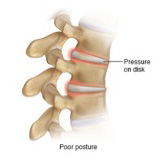
Americans spend seven to 10 hours sitting each day. Sitting affects metabolism, cardiac health and blood chemistry, but did you know that sitting also impacts your posture and overall spine health?
When you sit, your hip flexors (the front of your hip) and hamstrings (the back of your legs) can shorten, while their “opposite” counterparts grow weaker and inhibited. These muscles attach to your spine and pelvis for position and control.
If that’s not bad enough, know that your upper body is also affected. When you sit for extended amounts of time, the muscles at the front of your shoulders shorten, and those around your shoulder blades weaken. The overall effect is more slouching and continued poor posture.
Pressure on the shock absorbers (discs) in your spine is also increased when you sit. The pressure is even greater if you slouch or slump because your core muscles are not engaged.
Get Up! Stand Up!
What can you do if your job involves constant desk or computer work and a standing desk or office redo is out of reach? Get up and stretch! You can do these short activities throughout the day.
- While you are sitting, try to achieve ideal posture to decrease pressure in your spine and activate your core.
- Take walks to the copier throughout the day.
- Consider a standing or walking meeting.
- Stretch throughout the day – especially when on a phone call.
Stretch It Out
To start, stand tall with your ears, shoulders and hips in line. Your feet should be slightly apart, positioned just under your hips.
- Focus your eyes directly in front of you. Stand in this position for a few seconds before starting your exercise. This helps increase your awareness of proper posture.
- Reach overhead and slightly back with both arms. Keep your shoulders and neck aligned and your elbows behind your shoulders.
- With your palms facing the ceiling, turn your fingers inward.
- Take a deep breath.
- Breathe out and lower your elbows toward your buttocks. Hold for 5 seconds, then return to starting position.
- Repeat 3 times.
In another move:
- Stand and place place one heel on your chair.
- Use one or both hands on thigh for support.
- Keeping your torso straight, lean forward slowly until a stretch is felt in back of same thigh.
To consult with a physical therapist near you, talk with your orthopedic physician or learn more about orthopedic rehabilitation.